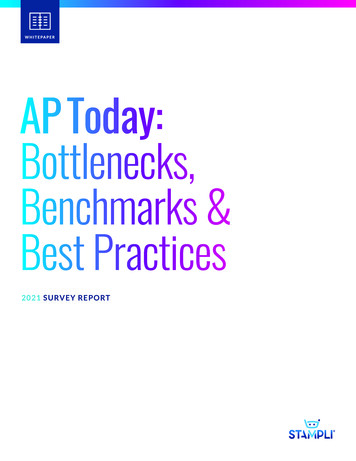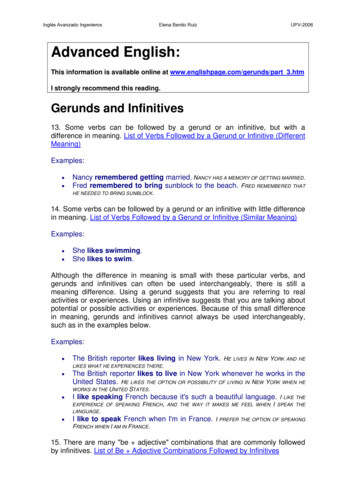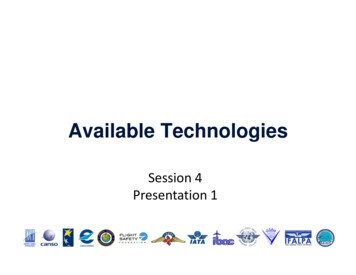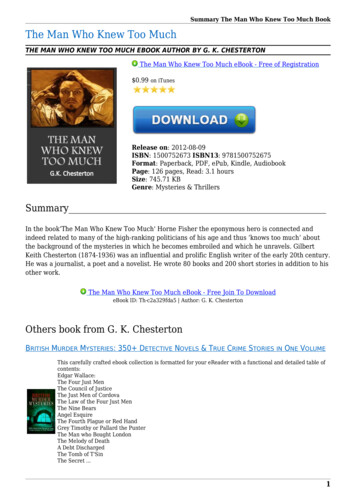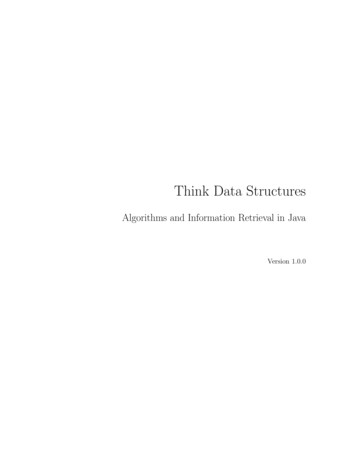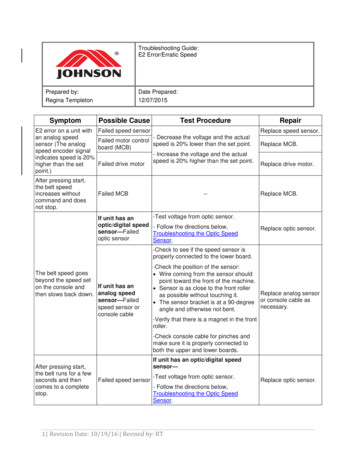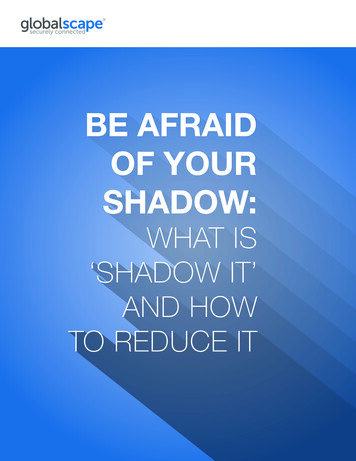
Transcription
Are you making it too easy for hackers to infiltrate your system?If your employees are using unsanctioned devices and applications,then the answer is yes! Unsanctioned devices and applications canleave your IT infrastructure and data far more vulnerable to beingexploited by cybercriminals. Unfortunately, it’s become easier thanever for employees to access rogue applications, much to thechagrin of busy IT staff.Since it’s become common for employees to bring their own laptops,tablets, and smartphones, administrators are put in a position to manageapplications of unknown origin and inadequate security standards. Itoften falls to the IT professionals to make sure these shadow IT effortsdon’t result in a fractured technology ecosystem that leaves networksvulnerable to a devastating attack.80% of IT prosreport end usersusing unsanctioneddevices andapplications.– IT Business Edge“[ ] more than 80 percent of IT pros said their end users have gonebehind their back to set up unapproved cloud services, with a whopping40 percent reporting their users ‘going rogue’ five or more times.” ITBusiness Edge, Majority of IT Pros Worry about Shadow IT UseWhile people generally have good intentions and are just trying to meetbusiness goals, employing shadow IT is indicative of a situation whereemployees are leaving security standards by the wayside.In this shadow IT guide, we not only talk about the growing problemof shadow IT in the workplace, but how you can take active steps toovercome shadow IT with the right strategy and tools in place.2
SECTION 1: WHAT IS SHADOW IT?Also known as “stealth” IT, shadow IT refers to the employee practiceof using a device or application to accomplish business objectivesor resolve IT-related issues outside the scope of IT and their securitypolicies. It’s a “do-it-yourself” practice of IT that is far from secure. Whilethe workaround can offer a short-term fix, it is a security risk that canhave a direct effect on your bottom line and reputation. The PonemonInstitute says the average data breach last year cost companies an70%of unauthorizedaccess to data iscommitted byan organization’sown employees.– Gigaomaverage of 4 million.70% of unauthorized access to data is committed by an organization’sown employees. Gigaom Research, Shadow IT: Data Protection andCloud Security.Whether it’s financial resources, business plans, personnel records,trade secrets or customer lists and sales projections, your businessrelies on data. When hackers access your data they can have a directeffect on your bottom line and reputation.SECTION 2: THE DRAWBACKS OF SHADOW ITFrom some perspectives, shadow IT fuels innovation. It shows howresourceful employees can be when they are trying to accomplish theirbusiness objectives. Unfortunately, there are far more drawbacks whenit comes to shadow IT, and they are often practicing shadow IT becausethey don’t know about or have access to user-friendly or secure tools.For that reason, they often seek a workaround to get the job done.It Can Compromise SecurityHackers are always on the lookout for a backdoor. Unfortunately, that iswhat an unsanctioned device or application can become—a backdoorinto your system, compromising your data and IT infrastructure. Anyapplication or device that is used within your organization must gothrough a full vetting process to ensure that it doesn’t interfere with yoursecurity measures.According to Ed Tech Magazine, 33% is the estimated percentage ofsuccessful attacks on institutions that will occur in shadow IT resourcesby 2020.3
It’s a Threat to Data PrivacyYour IT department needs visibility over your organization’s ITinfrastructure and data to ensure a more secure and productiveenvironment. Visibility allows IT to get ahead of problems, like catchingsecurity vulnerabilities or compliance violation risks. When it comesto shadow IT, there is little to no visibility and therefore it would beimpossible for IT to fully protect an organization’s data and infrastructure.Shadow IT puts the privacy of sensitive consumer and corporate dataat risk. There are particular types of data that require greater levels ofShadow IT putsthe privacyof sensitiveconsumer andcorporate dataat risk.protection due to their high value to cybercriminals. It’s also impossibleto protect and monitor the infrastructure or data when shadow ITpractices are at play. An example of this scenario is when an employeeuses a consumer file sharing application like Dropbox or Google Drive toshare or store sensitive customer data. Sharing data in this manner caneasily expose protected information and trigger breach notification laws.It Disrupts IT Processes and PoliciesOperational processes and procedures are a critical component of theIT infrastructure. Shadow IT can be very intrusive on the consistencyand reliability of these same processes and procedures. Considerhow quickly processes can fall apart when the IT staff is dealing withrequests to fix problems resulting from shadow IT.It’s a Threat to ComplianceWhat’s expensive and a huge hindrance to an organization’s abilityto operate and grow? Quite simply: compliance violations. Shadow ITcan eliminate or greatly reduce the amount of visibility IT has over theIT infrastructure. Without visibility and control over the user activitiesand data transfers happening with shadow IT, an organization is leftvulnerable to data loss. At the same time, the lack of visibility andcontrol in shadow IT-enabled environment can easily lead to complianceviolations if your sensitive and regulated data is unnecessarily exposedto security risk.4
It’s ExpensiveThere can easily be some degree of duplication when employees areprovisioning their own IT resources. If an employee or a departmentpurchases a tool without going through IT, then they’re not taking intoconsideration the potential need for IT support if a problem occurs. Atthe same time, they may not realize that IT already has a similar toolin place or they could’ve worked together to find a tool that supports35%of total ITexpenditures in2016 are relatedto shadow ITmanagement.– Gartner Researchtheir business needs while still maintaining a secure, compliant, andproductive environment. Taking the extra steps and collaborating with ITin advance will also save a great deal of time and money, as opposedto getting in a position where choosing to use an unauthorized toolmay mean that IT can’t support it or it may take more time to resolvetechnical problems.Gartner Research reports that shadow IT management will account for35% of total IT expenditures in 2016.SECTION 3: SIGNS THAT SHADOW IT ISA PROBLEMA Clear Shadow IT Policy Doesn’t ExistThe reality is that there are many employees that practice shadowIT and they are completely unaware that it’s wrong. In some casesthey either are not aware or they don’t understand your organization’ssecurity policies on the use of unauthorized devices or applications inthe workplace. If your employees are not clear about your shadow ITpolicy, then it may be a fair assumption that it’s happening within yourorganization.Help Desk Receives Requests for Unapproved SoftwareAs mentioned earlier, there are some employees who may not realizethat they are practicing shadow IT. They may be using software thatanother employee recommended, or it’s possible that their departmentmanager licensed a SaaS solution for their team without mentioningthat it wasn’t an approved solution. In these scenarios, employeessometimes still contact the company help desk for application issues.5
A Drop in Requests or ComplaintsSilence is another good indication of shadow IT. If employees wererequesting certain solutions and have seemingly fallen silent, it’spossible that they most likely found another option. Alternatively, if younotice that you have low email attachment size limits, or just don’t offertools for common needs (such as collaboration, reporting, file sharing,file transfers, and others), and no one complains about it, then it’s verylikely that shadow IT is alive and well. If needs go unmet for a moderateamount of time, employees will likely seek out other solutions.If you don’t offertools such ascollaboration,reporting, filesharing, filetransfers and noone complainsabout it, then it’svery likely thatshadow IT isalive and well.SECTION 4: HOW TO GET AHEAD OF SHADOW ITIf you find yourself dealing with shadow IT and need help with datamanagement, you’re not alone. Here are a few suggestions to helpreduce the burden of shadow IT.Take a Look at Existing ProcessesBy evaluate existing tools and policies, you may find shortcomingswhere your users are being enabled to create a shadow IT infrastructure.Reviewing these tools and policies is an easy first step in managingunsanctioned tools.Talk to Your EmployeesSurvey or audit your employees’ data management and transferprocesses. We all know that users do what’s easiest for them andthey will often try harder to find a work-around, rather than to becompliant. Instead of continuously fighting that battle, try to work withyour employees to establish common ground. Understanding why theyare work-arounds can help you determine a better route, such as moretraining or new tools to prevent any additional shadow IT problems.Keep it SimpleMake it easy for employees to follow a secure data management or filetransfer policy. Keep communications simple, clear, and direct. Provideend-user training on the policy annually, and to all new employees.Be sure to update the entire company on system security risks,communicating their role in preventing those risks.6
SECTION 5: SHINING THE LIGHT ON SHADOW ITReducing the practice of shadow IT can be achieved with the rightstrategy and tools in place. Among the tools that support a shadowIT-free environment includes the managed file transfer (MFT) platform.MFT can help organizations manage the secure movement of datafrom one location to another. With the right MFT platform and vendor,IT can centralize the management of data, allowing for greater visibilityand control. The visibility function of MFT can position IT to have amore thorough understanding as to how data moves throughout anVisibility gives IT astrategic advantage,so security orproductivity issuescan be addressedbefore theybecome a majorproblem, suchas a data breachor complianceviolation.organization. Visibility also gives IT a strategic advantage, so securityor productivity issues can be addressed before they become a majorproblem, such as a data breach or compliance violation.Employees practice shadow IT because they want to accomplish theirbusiness objectives in the most efficient way possible. To some degree,shadow IT can seem like an efficient way to accomplish an objective.It seems inexpensive and an easy way to get the job done, but it’salso a security risk, in part to the way shadow IT limits IT’s visibilityover the infrastructure. In addition to visibility, the right MFT platformwill lend itself to a more efficient infrastructure through automationcapabilities. Automating data transfer processes with MFT will not onlyhelp meet SLAs, but it will also ensure greater accuracy among yourcritical business processes, while also saving a great deal of time incomparison to manual processes.Here are a few key things to look for in an MFT solution: Military-grade security and compliance, built for the enterprise Comprehensive auditing and reporting Maximizing uptime through high availability and active-active clustering Maximum automation and system visibility Easy integration with other vendor products Secure mobile management7
SECTION 6: TOOLS THAT REDUCE SHADOW ITWhen an employee’s action puts information at risk or compromisescompliance, more often than not, there is no malicious intent. Rather,it’s a case of employees doing everything possible to remain productive,and losing sight of security and compliance in the process.If organizations want to ensure that employees follow policies andadopt the secure and managed tools that they provide, IT teams needto truly understand the business needs of the employees. The realityis that security inadvertently takes a backseat to productivity andWorkspacesfor EFT is easyfor end usersto share files–allowing others toaccess, upload,and downloadfolders andfiles securely.efficiency. If enterprises have any hope of managing and securing theirIT infrastructure and data, they need to provide solutions that easilyintegrate into the daily routines of their employees.SECTION 7: GLOBALSCAPE CAN HELPSay goodbye to shadow IT by choosing a managed file transfer solutionthat will help you empower your users and still keep your networksecure. With Workspaces for EFT, end users don’t have to ask for helpor worry about violating internal policies. Workspaces is easy for endusers to share files of virtually any kind via any web browser, allowingothers to access, upload, and download folders and files. Employeesare empowered to share files in a way that they have become use to,but now they can do it in a secure way, all while providing you with theenhanced governance and visibility of your data.8
ABOUT GLOBALSCAPEGlobalscape is an innovative software company that secures mission-critical exchanges of data across multiple platforms – including remoteand mobility solutions – for businesses worldwide. Through superiorsoftware, standards compliance and experienced, reliable support,Contact us today to begin yourfree trial of Workspaces forGlobalscape’s managed filetransfer platform, EFT obalscape secures information exchange for individual, globalenterprises, governments, and small and medium enterprises acrossa wide range of industries.Work Cited“Majority of IT Pros Worry About Shadow IT Use.”IT Business Edge. October 21, 2016“Average Cost of Data Breaches Rises Past 4 Million, Ponemon Says.”Information Week: Dark Reading. October 21, 2016“Shadow IT: Data Protection and Cloud Security.” Gigaom.October 21, 2016“Bring Shadow IT Out of the Dark.” EdTech.October 21, 2016“Why Shutting Down IT Stifles Innovation.”IT ProPortal. October 21, 2016 GlobalSCAPE, Inc. (GSB)Corporate Headquarters4500 Lockhill-Selma Road, Suite 150San Antonio, TX 78249 USASales: 210-308-8267 / Toll Free: 800-290-5054Technical Support: 210-366-3993Web Support: www.globalscape.com/support 2008-2016 GlobalSCAPE, Inc. All Rights Reserved // October 20169
IT-free environment includes the managed file transfer (MFT) platform. MFT can help organizations manage the secure movement of data from one location to another. With the right MFT platform and vendor, IT can centralize the management of data, allowing for greater visibility and control. The visibility function of MFT can position IT to have a
